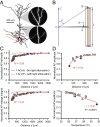Nonthermal and reversible control of neuronal signaling and behavior by midinfrared stimulation
- PMID: 33649213
- PMCID: PMC7958416
- DOI: 10.1073/pnas.2015685118
Nonthermal and reversible control of neuronal signaling and behavior by midinfrared stimulation
Abstract
Various neuromodulation approaches have been employed to alter neuronal spiking activity and thus regulate brain functions and alleviate neurological disorders. Infrared neural stimulation (INS) could be a potential approach for neuromodulation because it requires no tissue contact and possesses a high spatial resolution. However, the risk of overheating and an unclear mechanism hamper its application. Here we show that midinfrared stimulation (MIRS) with a specific wavelength exerts nonthermal, long-distance, and reversible modulatory effects on ion channel activity, neuronal signaling, and sensorimotor behavior. Patch-clamp recording from mouse neocortical pyramidal cells revealed that MIRS readily provides gain control over spiking activities, inhibiting spiking responses to weak inputs but enhancing those to strong inputs. MIRS also shortens action potential (AP) waveforms by accelerating its repolarization, through an increase in voltage-gated K+ (but not Na+) currents. Molecular dynamics simulations further revealed that MIRS-induced resonance vibration of -C=O bonds at the K+ channel ion selectivity filter contributes to the K+ current increase. Importantly, these effects are readily reversible and independent of temperature increase. At the behavioral level in larval zebrafish, MIRS modulates startle responses by sharply increasing the slope of the sensorimotor input-output curve. Therefore, MIRS represents a promising neuromodulation approach suitable for clinical application.
Keywords: action potential; excitability; infrared light; neuromodulation; potassium channel.
Copyright © 2021 the Author(s). Published by PNAS.
Conflict of interest statement
The authors declare no competing interest.
Figures






Similar articles
-
Sensory input-dependent gain modulation of the optokinetic nystagmus by mid-infrared stimulation in pigeons.Elife. 2023 Feb 28;12:e78729. doi: 10.7554/eLife.78729. Elife. 2023. PMID: 36853228 Free PMC article.
-
Voltage-gated potassium channels activated during action potentials in layer V neocortical pyramidal neurons.J Neurophysiol. 2000 Jan;83(1):70-80. doi: 10.1152/jn.2000.83.1.70. J Neurophysiol. 2000. PMID: 10634854
-
Single mechanically-gated cation channel currents can trigger action potentials in neocortical and hippocampal pyramidal neurons.Brain Res. 2015 May 22;1608:1-13. doi: 10.1016/j.brainres.2015.02.051. Epub 2015 Mar 9. Brain Res. 2015. PMID: 25765154
-
Plasticity of voltage-gated ion channels in pyramidal cell dendrites.Curr Opin Neurobiol. 2010 Aug;20(4):503-9. doi: 10.1016/j.conb.2010.06.006. Epub 2010 Aug 4. Curr Opin Neurobiol. 2010. PMID: 20691582 Review.
-
Neuromodulation of Na+ channels: an unexpected form of cellular plasticity.Nat Rev Neurosci. 2001 Jun;2(6):397-407. doi: 10.1038/35077553. Nat Rev Neurosci. 2001. PMID: 11389473 Review.
Cited by
-
Neural stimulation and modulation with sub-cellular precision by optomechanical bio-dart.Light Sci Appl. 2024 Sep 19;13(1):258. doi: 10.1038/s41377-024-01617-9. Light Sci Appl. 2024. PMID: 39300070 Free PMC article.
-
Recent advances and research progress on microsystems and bioeffects of terahertz neuromodulation.Microsyst Nanoeng. 2023 Nov 14;9:143. doi: 10.1038/s41378-023-00612-1. eCollection 2023. Microsyst Nanoeng. 2023. PMID: 38025884 Free PMC article. Review.
-
Regulation of Ion Permeation of the KcsA Channel by Applied Midinfrared Field.Int J Mol Sci. 2022 Dec 29;24(1):556. doi: 10.3390/ijms24010556. Int J Mol Sci. 2022. PMID: 36613998 Free PMC article.
-
Mid-infrared Photons Released by NAD+ Reduction in the Tricarboxylic Acid Cycle of Myelinated Neuron.Neurosci Bull. 2023 Jul;39(7):1146-1150. doi: 10.1007/s12264-023-01044-7. Epub 2023 Mar 15. Neurosci Bull. 2023. PMID: 36918516 Free PMC article. No abstract available.
-
Spintronic terahertz emission with manipulated polarization (STEMP).Front Optoelectron. 2022 Apr 21;15(1):12. doi: 10.1007/s12200-022-00011-w. Front Optoelectron. 2022. PMID: 36637604 Free PMC article. Review.
References
-
- Izzo A. D., Richter C. P., Jansen E. D., J. T. Walsh, Jr, Laser stimulation of the auditory nerve. Lasers Surg. Med. 38, 745–753 (2006). - PubMed
Publication types
MeSH terms
LinkOut - more resources
Full Text Sources
Other Literature Sources
Molecular Biology Databases

